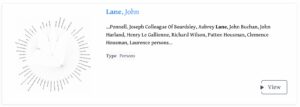To explore the Y90s Personography:
Search returns include data from the digital editions and editorial apparatus on Yellow Nineties 2.0. Returns specific to the Y90s Personography are visually identifiable by a circular network graph.
The Y90s Personography includes data cards for each contributor and publisher associated with the 8 titles on the Y90s magazine rack. Each entry in the database opens as a webpage that hyperlinks to related entities and identifies associated magazine volumes.
To search for contributors:
Type the individual person’s name in the search bar as Last, First.
Example: Lane, John

To search for publishers:
Review list of publishers and printers associated with specific titles and volumes of Y90s magazines.
Enter the name of the press in the search bar in natural order.
Example: John Lane, The Bodley Head

For more information:
- Visit the Data Model Page for an introduction to the Database structure.
- View the Ontology Specification Document (2.2) for a more detailed explanation of the classes, properties, attributes, and vocabulary of the Personography.
- View the Project Gallery exhibiting past research by members of the Y90s team.
- View list of publishers and printers associated with specific titles and volumes of Y90s magazines.
- Download the Persons and/or Publishers dataset in a .csv file (last updated spring 2023).
- Explore the dataset on LINCS (Linked Infrastructure for Networked Cultural Scholarship) on the Yellow Nineties Project Page in Research Space: https://rs.lincsproject.ca/resource/ThinkingFrames?view=search-yellowNineties